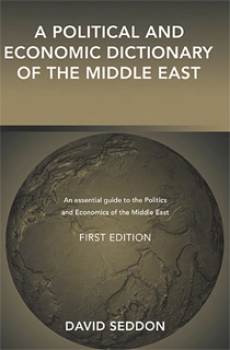| FOREWORD
The boundaries selected for this first Political and Economic Dictionary of the Middle East may appear somewhat arbitrary. It is difficult to define precisely ‘the Middle East’: this foreword attempts to explain the reasoning behind my selection. For the purposes of this Dictionary, the region includes six countries and one disputed territory in North Africa (Mauritania, Morocco, Algeria, Tunisia, Libya, Egypt and Western Sahara), eight countries in Western Asia (Jordan, Israel, Palestine, Lebanon, Syria, Turkey, Iraq and Iran), seven in Arabia (Saudi Arabia, Kuwait, the United Arab Emirates, Oman, Qatar, Bahrain and Yemen), five newly independent states in southern Central Asia (Kazakhstan, Kyrgyzstan, Turkmenistan, Tajikistan and Uzbekistan) and Afghanistan. It also, somewhat controversially, includes the ‘Turkish Republic of Northern Cyprus’. (A full treatment of Cyprus will appear in the companion volume A Political and Economic Dictionary of Western Europe.)
We have chosen not to include all of the countries where Arabic is spoken, although, arguably, many of the countries of the Sahelian region just south of the Sahara (Mali, Niger, Chad, Sudan), constitute in some sense a part of the ‘Arab world’, as do Djibouti and Comoros. These countries appear in a companion volume, A Political and Economic Dictionary of Africa. We have also chosen not to include Pakistan, despite its close links with Afghanistan, seeing it as more properly treated within the context of South Asia as a whole—although it is not ignored here either. Nor have we included the Caucasus region, despite its links with the Middle East.
We have, by contrast, chosen to include the predominantly Arabic-speaking countries of western North Africa (the Maghreb), including Mauritania (which is a member of the Arab Maghreb Union) and the non-Arabic-speaking countries in the northern part of the region that are sometimes referred to as ‘the northern tier’—Turkey, Iran, Afghanistan—and the relatively new independent republics in southern Central Asia, which previously constituted a part of the Union of Soviet Socialist Republics (USSR) or Soviet Union. The countries of Arabia and the Gulf constitute a distinctive yet integral part of the Middle East, while the history and location of Israel, despite its extraordinary characteristics, ensures that it remains, as it has done at least since 1948, at the centre of Middle Eastern politics.
Finally, although the majority of the population of the Middle East consists of Arabicspeaking Muslims, many are members of important ethnic, linguistic and religious minorities, with their own distinctive economic, social, cultural and political concerns, ensuring that the politics and economics of the Middle East are both complex and complicated. This should provide an important counter to any tendency to equate the region with either ‘the Arab world’ or ‘the world of Islam’. In the world of the 21st century, particularly following the events of 11 September 2001, we need to be both more aware of, and at the same time cautious about generalizing from, the complex phenomenon which is ‘political Islam’. In the same way, although for many analysts the defining feature of the region is ‘the oil economy’, which contributes crucially to the global geo-political significance of the region, there are major differences between not only the oil-producing and—exporting countries and those dependent on oil and energy imports within the region, but even between these categories and groupings. While there is a sense in which it is possible to identify a regional economy, in terms of the links provided by flows of capital, commodities and labour within the region, most economies in the region have more important and often arguably defining links outside the region. It is therefore as dangerous to generalize about the Middle East as it is any region in the world. This is not only because it consists of a considerable number of different and distinct states and territories, each with its own unique history, environment, economy, society and cultural and political characteristics, but also because much depends also on which of these countries and territories is/are included in the generalizations. For example, the Arab Human Development Report, which provides a valuable up-to-date account of the economic, social and political dynamics and status of ‘the Arab countries’, fails to include the non-Arab countries of the Middle East and therefore cannot strictly be used to make comparisons with other aggregates, such as ‘the Middle East and North Africa’ or ‘the Middle East’ as used by other agencies including the United Nations and the World Bank.
If the Middle East is clearly—as this introductory section has attempted to demonstrate—more than the sum of its parts, a full appreciation would require a comprehensive study. That is not the purpose of this book, which is designed rather as a reference work, providing succinct and up-to-date entries for a wide range of political and economic topics, organizations, institutions, individuals, and of course for the countries which together comprise the region.
Entries are arranged alphabetically, and cross-referencing between entries is indicated by the simple and widely familiar device of using a bold typeface for those words or entities which have their own coverage.
The reader is, however, recommended as companions to this Dictionary, the very full reference books provided by, for example, The Middle East and North Africa and Africa South of the Sahara, also published by Europa Publications, and the Political and Economic Dictionaries of other regions of the world.
David Seddon
October 2004 |
